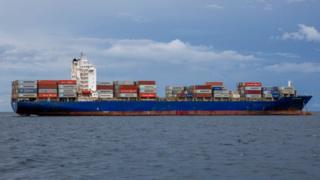
Climate change: Fertiliser could be used to power ocean-going ships
- Ocean-going ships could be powered by ammonia within the decade as the shipping industry takes action to curb carbon emissions.
Ocean-going ships could be powered by ammonia within the decade as the shipping industry takes action to curb carbon emissions.
The chemical – the key ingredient of fertilisers – can be burned in ships’ engines in place of polluting diesel.
The industry hopes ammonia will help it tackle climate change, because it burns without CO2 emissions.
The creation of the ammonia itself creates substantial CO2, but a report says technology can solve this problem.
The challenge is huge, because shipping produces around 2% of global carbon emissions – about the same as the whole German economy.
Making ammonia is also a major source of carbon. A report by the Royal Society says ammonia production currently creates 1.8% of global CO2 emissions – the most of any chemical industry.
But the authors of the report say new technology can create zero carbon ammonia. One way is by trapping the CO2 emissions created when ammonia is produced, and burying the CO2 in underground rocks.
Another way of making so-called “green” ammonia is to use renewable energy which doesn’t create any CO2.
But the big question is whether enough clean energy will be available to create ammonia at scale in the coming decades.
What’s so good about ammonia?
Ammonia is an invaluable jack-of-all-trades chemical – but it is a menace in the wrong place.
It is shipped in bulk as an essential base for chemicals, textiles, explosives, refrigerants and fertilisers.
But when it is spread carelessly on fields it causes air and water pollution, and it can react with other chemicals to make greenhouse gases.
The Royal Society report says farmers need to use ammonia much more carefully.
But it notes that the near ubiquitous use of ammonia for agriculture has conveniently generated a global network of ports where the chemical is traded or stored.
That means the infrastructure for storing chilled ammonia as a shipping fuel already exists. In the USA, for instance, one existing ammonia pipeline runs for 2,000 miles.
How soon could ammonia be powering ships?
The engine designer Man Energy Solutions is making a two-stroke ammonia-powered engine it hopes will be ready by 2024.
The firm’s spokesman, Peter Kirkeby, told the BBC: “We see a very big interest from the market in ammonia as a fuel – even though there are challenges.
“We expect the first ships fuelled with ammonia will be existing tankers that are already transporting ammonia for fertiliser. They know how to handle it.”
He said he expected ammonia to match the price of other alternative fuels such as liquefied petroleum gas, liquefied natural gas or methanol.
However, the report shows how inefficient these fuels are compared with energy-dense diesel.
This means that ships powered by greener fuels need to set aside more valuable space for fuel storage.
That’s why the report’s authors say hydrogen will be too bulky to fuel ocean-going ships.
And there’s a further problem. Burning ammonia may not cause CO2 emissions, but it does create nitrogen oxides, which are also greenhouse gases. The report says technology will need to be developed to deal with this.
Is there a bit of wishful thinking on ammonia?
The Royal Society’s lead author, Prof Bill David, told the BBC: “Ammonia is the only zero-carbon fuel that will get you across the oceans.”
But he warned: “In terms of emissions from industrial processes, ammonia comes only after cement and steel, so we need to decarbonise the production of ammonia.”
A recent academic report called Absolute Zero was sceptical as to whether the ammonia industry could expand fast enough to power ships, while decarbonising at the same time.
It said the implementation at scale of ammonia from renewables would be an additional burden to the decarbonised power grid.
Prof David disagrees. He says: “Ammonia is the only way to store zero-carbon fuel from renewables for days, months and years.”
The UN shipping body, the IMO, has a target of halving emissions from international shipping by 2050 compared with 2008.
A group of major shipping owners says $2 (£1.50) should be levied on every tonne of ships’ fuel to support research into clean engines.
Environmentalists have consistently complained the industry is not playing its part in reducing emissions. In the short term they want to reduce the amount of shipping overall, and impose slower cruising speeds to save fuel.



